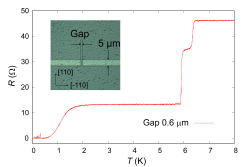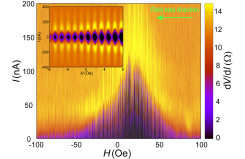Supercurrent in a Ferromagnetic Semiconductor
Katsumoto Group
The origin of superconductivity is the pairing of two electrons (Cooper pairing). In conventional superconductors such a pairing occurs between electrons with opposite spins and momentums at the Fermi surface. The total spin of a conventional Cooper pair is, thus zero (spin-singlet pairing). There may exist, however, another type of pairing with total spin one, that is, spin-triplet pairing. A solid example is the pairing of two helium-3 atoms in the state of superfluidity. Many exotic properties are predicted for spin-triplet (odd parity) superconductivity though few of them have been experimentally confirmed. Spin-triplet superconductivity may appear in non-uniform superconductivities such as proximity driven superconductivity in a half-metallic ferromagnetic material, in which only a single spin state exists at the Fermi level. In this study, we have made a diluted ferromagnetic semiconductor (In, Fe)As [1] superconducting by placing Nb split electrodes with gaps around 1 μm. The magnetic field dependence of the critical current suggests that the spin-triplet pairing is presumably realized in (In, Fe)As.

Fig. 1. Two-terminal resistance of a Nb-(In, Fe)As-Nb junction as a function of the temperature. The inset shows optical micrographs of the sample, which consists of 5 μm wide Nb strips and 0.6 μm width gap of (In, Fe)As.

Fig. 2. Differential resistance of the sample shown in Fig.1 is plotted in color as a function of the perpendicular magnetic field and the device current. The inset is a blowup around the origin, which shows clear diamond-like zero-resistance regions. The green arrow indicates the direction of the field sweep.
The (In, Fe)As film was grown in Tanaka laboratory in Department of Electrical Engineering and Communication Technology, University of Tokyo by molecular beam epitaxy. As shown in the inset, Nb strips with the width 5 μm were deposited leaving the gap of 0.6 μm as shown in the inset of Fig. 1. Figure 1 displays the temperature dependence of the sample resistance, which have a two-step drop at the transition temperature of Nb. Below 1.5 K, the resistance decreases again with decreasing temperature and reaches zero around 0.5 K. In Fig. 2, we plot the differential resistance in color as a function of the perpendicular magnetic field and the device current. A Fraunhofer-like interference pattern with a very short period in magnetic field appears with a shifted broad peak. The period much shorter than that for single flux quantum in the junction area comes from flux concentration by the Nb electrodes.
A peculiar point is that the peak position exists on the positive side of zero magnetic field while the field is swept from positive to negative. For the opposite sweep direction, the peak position appears on the negative side. This means the critical current is affected by hysteretic magnetization of the ferromagnet. Then why the peak is formed for high magnetic flux position? The key is magnetic disorder at the interface between (In, Fe)As and Nb. The peak always exists when the disorder is maximized, which fact suggests the spin-triplet pairing is realized in ferromagnetic (In,Fe)As.
References
- [1] M. Tanaka, S. Ohya, and P. Nam Hai, Appl. Phys. Reviews 1, 011102 (2014).
